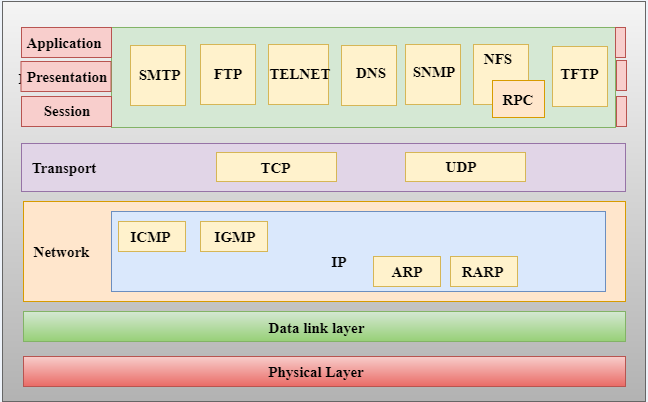Explain Different Protocols of Tcp/ip Model
Protocol is used to connect to the host so that the packets can be sent over it. IP address to IP address via router.

Computer Network Tcp Ip Model Javatpoint
However the TCPIP model consists of four different layers unlike the OSI model which has seven layers.

. Every message which is sent by an application has to pass. The IP and TCP protocols together are called TCPIP protocols in computer networks. 10 rows TCPIP OSI.
The TCPIP Protocol Suite. The department of defence developed the protocol of TCPIP. A network layer is the lowest layer of the TCPIP model.
The TCPIP Reference Model and Protocol Suite Explained. The TCPIP model works because the whole process is standardized. The network layer handles network to network communication.
Different Layers of TCPIP Reference Model. The prime objective of the TCPIP model is to allow long-distance communication. The TCPIP Protocol Stack is built primarily to provide an extremely stable and end-to-end byte stream over an insecure internet network.
Transmission Control ProtocolInternet Protocol TCPIP are two different communication protocols. TCPIP Transmission Control ProtocolInternet Protocol is a set of protocols that are used for data transmission over computer networks. OSI refers to Open Systems.
TCPIP means Transmission Control Protocol and Internet Protocol. It is the network model used in the current Internet architecture as well. TCPIP is a hierarchical protocol made up of interactive modules and each of them provides specific functionality.
Up to 10 cash back A diagram of how the TCPIP model divides data into packets and sends it through 4 different layers. This is the top layer of TCPIP protocol suite. The TCPIP model recognizes the main functionalities of the theoretical OSI model.
Without standardization communication would go haywire and slow things down and fast internet service relies on efficiency. The four layers in the TCPIP protocol suite are. The TCPIP model has four simple layers Application Transport Internet and Link.
TCPIP was designed to be independent of networking Hardware and should run across any connection media. TCP splits a message to packets which were transmitted across the internet whereas the IP is accountable to address of every packet hence a chance to forward the exact destination. The full form of TCPIP protocol is Transmission Control Protocol and Internet Protocol.
These protocols describe the movement of data between the source and destination or the internet. The protocol suite is named after two of the most common protocols TCP transmission Control Protocol and IP internet Protocol. Just like the OSI model its numbered from the bottom up but the direction depends on if youre sending or receiving data.
Similar to the OSI model the model is designed to map all aspects of network communication. The image below presents the corresponding layers of both TCPIP and OSI models. Each layer usually has more than one protocol options to carry out the responsibility that the layer adheres to.
OSI uses the network layer to define routing standards and protocols. This model acts as a communication. TCPIP means Transmission Control Protocol and Internet Protocol.
Below we have discussed the 4 layers that form the TCPIP reference model. This layer is included in the reference model but no specific protocol is. Here hierarchical means that each upper-layer protocol is supported by two or more lower-level protocols.
7 rows The TCPIP model is a part of the Internet Protocol Suite. Host-to- Network Layer It is the lowest layer that is concerned with the physical transmission of data. Original and Updated Model.
Lowest layer of the all. Thankfully its not that different. Explain the Layers of TCPIP.
Through utilizing a protocol named TCPIP the internet operates. Protocols are set of rules which govern every possible communication over a network. The layers in the TCPIP model are assigned various tasks and therefore protocols.
Functions of TCPIP layers. TCPIP is normally considered to be a 4 layer system. It is named after the two main protocols that are used in the model namely TCP and IP.
TCPIP uses only the. The TCPIP model however is the real deal. Previously there was no TCPIP and no method for the computers to.
TCP refers to Transmission Control Protocol. A network layer is the combination of the Physical. This model is based upon two standard protocols such as internet protocol and transmission control protocol.
This layer handles end-to-end communication between devices on a network s the method for the connection TCP or UDP is decided on this level and the data being transmitted is segmented into packets and sent along to the network layer. TCPIP that is Transmission Control Protocol and Internet Protocol was developed by Department of Defences Project Research Agency ARPA later DARPA as a part. TCP stands for Transmission Control Protocol and IP stands for Internet Protocol.
The internets fundamental networking language is TCPIP. We have seen the different protocols that are used at each layer of the TCPIP model to. Varies from host to host and network to network.
The 4 layers are as follows. The TCPIP protocol suite consists of many protocols that operate at one of 4 layers. It is the network model used in the current Internet architecture.

The Tcp Ip Protocol Framework Networking Tutorial

How The Tcp Ip Protocols Handle Data Communications System Administration Guide Ip Services

Belum ada Komentar untuk "Explain Different Protocols of Tcp/ip Model"
Posting Komentar